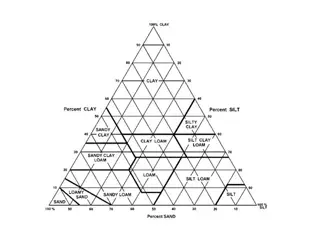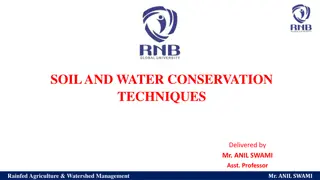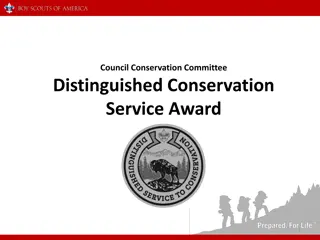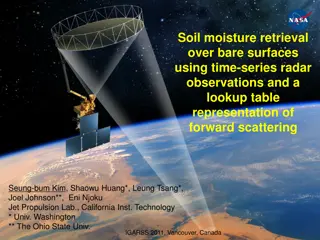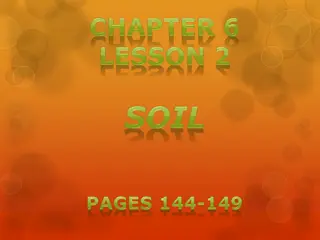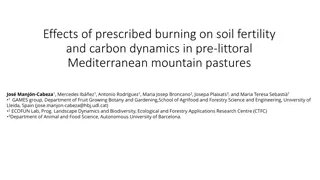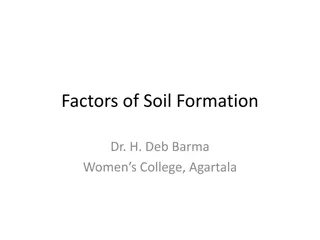NRCS Programs Update
The Inflation Reduction Act (IRA) provides $20 billion to support USDA's conservation programs focusing on climate-related benefits and agricultural resilience. It allocates funds for programs like the Environmental Quality Incentives Program, Agricultural Conservation Easement Program, Regional Con
2 views • 14 slides
Understanding Principles and Practices of Water Management in Agriculture
This course delves into the field water cycle, water movement in soil and plants, soil-plant-water relationships, water dynamics in the soil-plant-atmosphere system, soil composition, soil texture classification, permeability factors, density of soil solids, total porosity assessment, and energy asp
8 views • 62 slides
Evaluation of SPLASH and HRRR Soil Moisture Comparison
This study compares soil moisture data between the HRRR model and SPLASH observations during the 2022 warm season. It explores differences in soil moisture levels at various depths, evaluates responses to precipitation events, and drydown periods. The research focuses on analyzed data from HRRR Mode
3 views • 12 slides
Understanding Water Management: Principles, Practices, and Soil-Water Relations
Explore the principles and practices of water management in agriculture with a focus on water availability, nutrient relationships, and losses. Discover the physical classification of water, available water defined between field capacity and wilting point, soil water potential, and the soil-plant-at
6 views • 17 slides
Understanding the Fate of Herbicides in Soil
The fate of herbicides in soil is influenced by factors such as micro-organism decomposition, chemical decomposition, photodecomposition, adsorption by soil, surface runoff, leaching, plant uptake, and volatilization. Micro-organisms like algae, fungi, actinomyces, and bacteria play a crucial role i
6 views • 7 slides
Effective Methods for Soil Conservation
Methods to reduce soil erosion and promote soil conservation include terracing, contour planting, strip cropping with cover crops, alley cropping, agroforestry, windbreaks, and conservation tillage practices such as no-till and minimum tillage. These methods help in minimizing soil erosion hotspots
2 views • 11 slides
Soil and Water Conservation Techniques in Rainfed Agriculture by Mr. Anil Swami
Explore soil erosion and various conservation techniques discussed by Mr. Anil Swami, an Assistant Professor specializing in Rainfed Agriculture and Watershed Management. Learn about prevalent soil and climatic conditions in rainfed areas, water harvesting techniques, contingent crop planning, seaso
0 views • 66 slides
Council Conservation Committee Distinguished Conservation Service Award
The Council Conservation Committee Distinguished Conservation Service Award is a prestigious recognition in scouting, involving projects, workbook completion, and assessment by a Council Board of Review. Councils must establish their own policies for administering the award. Scouts recognized with a
1 views • 20 slides
Understanding the Importance of Humus in Soil Health
Humus, the organic residue in soil, plays a crucial role in soil fertility and plant growth. It improves soil structure, retains water, stores essential nutrients, and promotes microbial activity. Factors like soil fertility, moisture, temperature, and pH influence the distribution and activity of s
0 views • 21 slides
Understanding Composition of Soil Organic Matter in Soil Microbiology
Soil organic matter is vital for soil properties and plant nutrition. It consists of plant residues, animal remains, and microbial tissues, comprising complex compounds like carbohydrates, proteins, fats, and more. The composition varies with plant type, age, and nature. Leguminous plants are rich i
0 views • 19 slides
Understanding Soil and Foundation Engineering Fundamentals
Soil plays a crucial role in engineering, with unique properties that influence its mechanical behavior. This article covers the formation of soil, types including residual and transported soils, and the phases of soil in nature. Explore phase diagrams, relationships between volume, void ratio, and
0 views • 20 slides
Soil Conservation Practices: Building an A-Frame for Erosion Control
Learn about the importance of soil conservation practices and how to build and utilize an A-frame tool for erosion control. Discover the causes of soil erosion and effective techniques like contour lines, contour planting, and vegetative barriers to prevent soil degradation. Find out how to construc
2 views • 14 slides
Understanding Soil Microbiology and Its Impact on Plant Growth
Soil microbiology is a branch of science that focuses on studying soil microorganisms and their activities, which play a crucial role in supporting plant life. Soil consists of organic and inorganic matter, water, and living organisms that interact in complex ways to influence plant growth and nutri
1 views • 11 slides
Marine Conservation Governance in Raja Ampat, West Papua, Indonesia
Explore the dynamics of marine conservation governance in Raja Ampat, West Papua, Indonesia, with a focus on Sasi practices and the preliminary findings in the West Misool and South Misool districts. Discover the potential resources in Raja Ampat and the various types of marine conservation areas in
0 views • 22 slides
Soil Disinfestation Methods for Greenhouse Crop Production
Soil mixes for greenhouse production are carefully designed to optimize water retention and aeration. Proper management of artificial soil mixes can yield crops equal to those grown in topsoil. Sterilization of growing media is crucial, with techniques such as steam sterilization and fumigation comm
0 views • 11 slides
Understanding Soil Chemistry and Redox Reactions in Environmental Chemistry
Soil chemistry plays a crucial role in sustaining healthy soils by influencing nutrient availability through oxidation and reduction processes. Redox reactions in soil are impacted by factors like oxygen content and water presence, affecting nutrient supplies. The redox status of soil reflects its n
1 views • 92 slides
Understanding the Diversity of Microorganisms in Soil Ecosystems
Microorganisms in soil play crucial roles in soil fertility, nutrient cycling, and industrial product synthesis. They can also be pathogens causing diseases in plants and humans. Soil organisms are broadly classified into two groups: soil flora and soil fauna, consisting of various microorganisms li
0 views • 57 slides
Conservation Easements and Monitoring in Orange County by The Nature Conservancy
The Nature Conservancy plays a vital role in monitoring and managing conservation easement lands in Orange County, ensuring the protection of conservation values and natural resources. Through the Irvine Ranch Conservation Easements, they uphold specific permitted and prohibited activities while tai
0 views • 19 slides
Understanding Soil Composition and Importance
Explore the world of soil and its significance as a natural resource by discovering its composition and how it affects plant growth. Learn about the main ingredients of soil, its permeability, and the role of water, air, and organic matter. Gain insights into how soil supports plant life through lea
1 views • 30 slides
Understanding Energy Efficiency and Conservation Fundamentals
This unit introduces basic terms related to energy, efficiency, and conservation, covering topics such as Efficiency and Conservation Energy, First and Second Law of Thermodynamics, and various heat transfer mechanisms. It emphasizes responsible energy use, focusing on efficiency, conservation, and
0 views • 14 slides
Construction Safety and Soil Mechanics Overview
This content provides valuable information on excavation, trenching, soil mechanics, OSHA regulations, common violations in construction and excavation, fatal incidents, soil composition, and soil weight calculations. It emphasizes the importance of following safety protocols in construction work re
0 views • 45 slides
Diaz Farm Conservation Journey in Illinois
Explore the 17-year conservation journey of Diaz Farm in Stephenson County, Illinois, led by Dan Diaz, focusing on sustainable land management practices and the use of Resource Stewardship Evaluation Tool for conservation planning. The farm's history, conservation engagement with various organizatio
0 views • 9 slides
Understanding Soil Erosion and Conservation in 6th Grade Science
Soil erosion is the process of soil wearing away, commonly caused by natural forces like wind, water, gravity, and ice, as well as human activities such as farming, mining, and construction. Severe weather events can accelerate soil erosion. Soil conservation techniques like crop rotation, conservat
0 views • 12 slides
Soil Chemistry and Mineralogy Analysis at CSU Summer Soil Institute
Explore the comprehensive analysis of soil chemistry, texture, and mineralogy conducted at the CSU Summer Soil Institute in July 2010. The study delves into pedology, elemental composition, particle size distribution, X-ray diffractometry, and mineralogical composition of various soil samples. Detai
0 views • 22 slides
Soil Moisture Retrieval Over Bare Surfaces Using Radar Observations
This study focuses on retrieving soil moisture over bare surfaces using radar observations and a lookup table representation of forward scattering. The research aims to develop a non-empirical and simple method for accurate soil moisture retrieval without the need for ancillary information. Issues w
0 views • 14 slides
Understanding Soil Characteristics and Ecosystem Interactions
This content explores various aspects of soil characteristics, including factors influencing soil thickness, the role of bedrock in soil quality, optimal soil mixtures for plant growth, the impact of living organisms on weathering, and the formation of soil. It also discusses how animals can help so
0 views • 17 slides
Understanding Soil: Formation, Composition, and Impact on Plant Growth
Soil is more than just dirt; it plays a vital role in supporting plant growth. Formed through the weathering of rocks and organic activity, soil consists of rock fragments, clay, and organic material. The process of soil formation begins with the erosion of bedrock, leading to the development of dif
0 views • 12 slides
Exploring the Fascinating World of Soil: An Insightful Journey
Delve into the intricate composition of soil through a hand lens to uncover rocks, minerals, and humus. Discover the hidden elements like water, air, and living organisms that form the foundation of soil. Witness the decomposition process by bacteria and fungi, and explore the layers of a soil profi
0 views • 15 slides
Impacts of Prescribed Burning on Soil Fertility in Mediterranean Pastures
This study investigates the effects of prescribed burning on soil fertility and carbon dynamics in Mediterranean mountain pastures. It explores how soil responds to disturbance by prescribed burning, potential legacy effects based on pre-burning conditions, and the role of local microtopography in s
0 views • 8 slides
Understanding Factors of Soil Formation and Soil Geography
Soil formation is a complex process influenced by factors like weathering, organic matter, and minerals. Soil geography studies soil distribution using geographic methods and cartography. Various definitions of soil highlight its importance for plant growth and as a natural body with distinct horizo
0 views • 20 slides
Understanding Conservation and Taking Action
Explore the purpose of conservation and learn how to plan and execute conservation projects using local, regional, and national resources. Discover the legacy of the ArrowCorps service project and understand the difference between conservation and preservation. Identify conservation issues and resou
0 views • 12 slides
Conservation Challenges and Opportunities in the 2018 Farm Bill
The 2018 Farm Bill presents a battleground where conservation, environmental protection, and agricultural interests collide. Key issues include changes in the Clean Water Act, pesticide use, CAFO operations, NEPA requirements, and potential impacts on conservation programs like the Conservation Stew
0 views • 7 slides
Understanding Soil Health for Sustainable Ecosystems
Soil health, defined as the capacity of soil to function as a living ecosystem supporting plants, animals, and humans, is crucial for sustaining life. This content explores the imperatives, opportunities, and key practices such as no-till and cover crops to enhance soil health. It also delves into d
0 views • 33 slides
Microbial Transformations of Nitrogen in Soil: Factors, Forms, and Impact on Plant Nutrition
Understanding the microbial transformations of nitrogen in soil is crucial for optimizing plant nutrition. Factors such as climate, water supply, cultivation, soil texture, and depth influence the nitrogen content in soil. The different forms of soil nitrogen, including inorganic and organic compoun
0 views • 23 slides
Understanding the Role of Soil Biology in Lawn Care
Soil biology plays a crucial role in maintaining healthy and vibrant lawns. Various organisms, including invertebrates, plant roots, mycorrhizae, and micro-organisms, contribute to functions such as soil structure maintenance, regulation of soil hydrological processes, gas exchange, carbon sequestra
0 views • 27 slides
Importance of Describing Soil Profiles for Soil Suitability Analysis
Proper classification and interpretation of soil properties through describing soil profiles are essential in determining soil suitability for various uses. Soil classification involves describing, classifying, and interpreting soil properties to understand the best uses and limitations of the soil.
0 views • 5 slides
Understanding the Scope and Importance of Soil Microbiology in Ecosystems
Soil microbiology plays a significant role in supporting plant communities and maintaining soil health. Living organisms, both plant and animal types, form only a small fraction of soil mass but are crucial for processes like plant growth, organic matter decomposition, humus formation, and biogeoche
0 views • 14 slides
Plenary Session III on Forest, Soils, and Runoff Featuring Key Speakers
The Plenary Session III on Forest, Soils, and Runoff showcased insights from prominent figures such as Roland Quitugua, President of the Northern Soil and Water Conservation District, Joseph Mafnas, Chief of Forestry and Soil Resources at the Department of Agriculture, and Felix Benevante, Deputy Di
0 views • 4 slides
Understanding Conservation Principles in Fluid Dynamics and Classical Mechanics
Conservation principles play a significant role in fluid dynamics and classical mechanics. In fluid dynamics, conservation of mass, momentum, and energy are crucial for understanding fluid behavior. Classical mechanics, on the other hand, relies on Newton's laws to describe motion and energy conserv
0 views • 46 slides
Understanding Biodiversity Conservation and Its Importance
Exploring the concept of biodiversity conservation supported by the National Science Foundation, this work delves into the impacts of human activities on biological diversity, compares current extinction rates with past events, evaluates species conservation priorities, and distinguishes between ex
0 views • 16 slides





